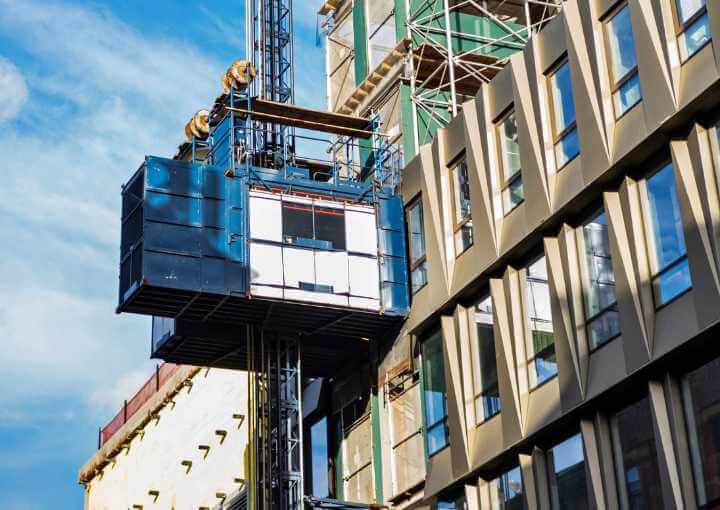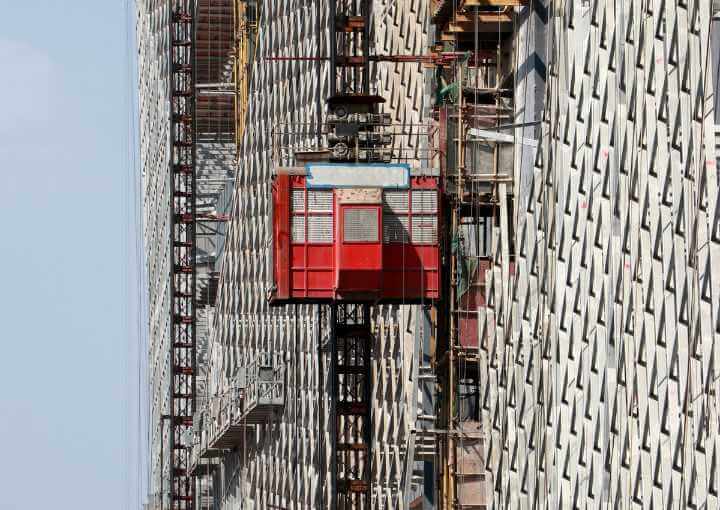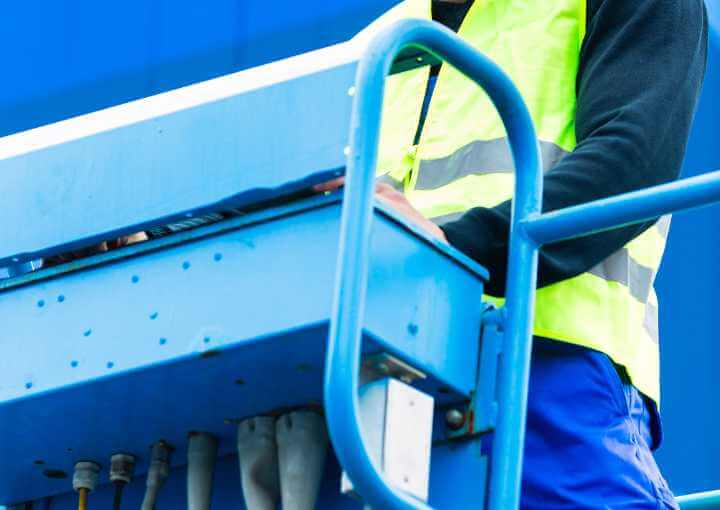Construction Passenger Lifts: Benefits, Costs, Types, and Safety
Passenger lifts are becoming an increasingly popular choice for construction sites, offering a safe and efficient way to move people and materials to different levels of a building.

Muneer Ahammed | Updated on May 04 2023
With the right passenger lift, you can save time and money, while also improving the safety of your site. This article will discuss the benefits and costs of using a construction passenger lift, explore the regulations and installation process, and offer advice on how to choose the right lift for your project.
Construction Passenger Lifts; A Comprehensive Guide

A construction passenger lift is a platform lift that is specifically designed to transport passengers and their materials to different levels of a building. These lifts are typically free-standing and require no additional support structure.
They are often used on construction sites, as they are a cost-effective and convenient way to move people and materials safely and quickly.
These lifts are available in different sizes, depending on the size of the building and the number of passengers and materials that need to be moved.
Some models are designed to carry up to 12 passengers, while others are designed to carry up to 25 passengers.
The lift can be powered by electricity or hydraulics, and the speed of the lift can be adjusted to suit the needs of the construction site.
Benefits of using Passenger Lifts for Construction Sites
Using a construction passenger hoist has several advantages for construction sites.
1. Saves time and improves efficiency
The most obvious benefit is that a lift can reduce the amount of time spent moving people and materials between different levels of the building. This can help to improve the efficiency of the work, as well as reduce any potential delays or disruptions.
2. Enhances safety
They improve safety on a construction site. By providing a safe and secure way to transport people and materials, the risk of injury or accidents is reduced. This can help to ensure that the site remains safe and compliant with all relevant regulations and standards.
3. Reduce Labour
They can also reduce the need for manual labour. A lift can also reduce the amount of time required to move materials, as it can move large loads quickly and easily.
Types of passenger lift for construction sites
There are several types of passenger lifts that can be used in construction sites, each with its own features:
1. Hydraulic Lifts
These lifts use hydraulic fluid pressure to raise and lower the car. They are often used in low-rise buildings and are known for their smooth and quiet operation.
Features:-
- Reliable and low maintenance
- Smooth and quiet operation
- Can be installed in a pit or on top of a building
2. Traction Lifts
These lifts use a cable and pulley system to raise and lower the car. They are often used in high-rise buildings and are known for their speed and efficiency.
Features:-
- Fast and efficient
- Can handle heavy loads
- Can travel longer distances
3. MRL (Machine Room Less) Lifts
MRLpassenger lifts use gearless motors to save space. They do not require a separate machine room, which makes them ideal for buildings with limited space.
Features:-
- Space-saving design
- Quiet operation
- Efficient energy consumption
4. Dumbwaiter Lifts
These lifts are small freight elevators used to transport goods between different floors. They are often used in commercial kitchens, restaurants, and small offices.
Features:-
- Small and compact design
- Easy to install
- Can handle small loads
These are some of the most commonly used passenger lifts for construction sites. The type of lift chosen will depend on the specific requirements of the building, such as the number of floors, the load capacity, and the available space.
Costs and Power Consumption of Construction Passenger Lifts

The passenger lift cost can vary depending on the size and type of the lift, as well as its power source. Electric lifts are more expensive than hydraulic lifts, as they require more power to operate. The cost of installation is also a factor, as the lift must be properly installed to ensure safety and efficiency.
The power consumption of a construction passenger lift will also vary depending on the size and type of the lift.
Generally, electric lifts are more power-hungry than hydraulic lifts, as they require more energy to operate.
The power consumption of the lift can also be affected by the type of material used in the construction of the lift and the speed at which it is operated.
Regulations and standards of Passenger Lift for Construction
Passenger lifts are regulated by various national and international standards to ensure the safety of their users. Some of the key passenger lift regulations for construction sites include
- EN 81: This is the European standard for safety rules for the construction and installation of elevators.
- ASME A17.1: This is the American standard for elevators and escalators.
- ISO 4190: This is the international standard for lift installations and includes requirements for the design, construction, testing, and maintenance of lifts.
The use of a construction passenger lift is subject to various regulations and standards. Depending on the country, these regulations may vary, so it is important to be familiar with the relevant regulations and standards before installing a lift on a construction site.
In most countries, construction passenger lifts are subject to the same safety regulations as other types of lifts.
This includes regulations on the design and installation of the lift, as well as the operation and maintenance of the lift. The lift must also be installed in accordance with the relevant building codes and regulations.
It is also important to ensure that the lift has been tested and certified to be safe and compliant with the relevant regulations and standards.
This can help to ensure that the lift is safe and efficient, and can help to reduce any potential risks.
Passenger lift regulation for safety in UAE
In the United Arab Emirates (UAE), the regulations and standards governing the construction of passenger lifts are set by the Dubai Municipality and the Emirates International Accreditation Centre (EIAC). The Dubai Municipality Building Code and the Dubai Civil Defense Code outline the requirements for lift installation and operation. The EIAC provides accreditation for the testing and certification of lifts.
In other countries, the regulations and standards may vary, but some commonly recognized organizations include:
- International Organization for Standardization (ISO)
- International Electrotechnical Commission (IEC)
- European Committee for Standardization (CEN)
- British Standards Institution (BSI)
- Japanese Industrial Standards (JIS)
- National Association of Elevator Safety Authorities International (NAESA)
It is important to note that local building codes and regulations should always be consulted to ensure compliance with all relevant standards and regulations.
Choosing the Right Passenger Lift for Flat Construction Sites
When choosing a passenger lift for a flat construction site, there are several factors to consider.
The most important factor is the size of the lift. Generally, the size of the lift should be determined by the number of passengers and materials that need to be moved.
If the lift is too large, it can be difficult to manoeuvre on the site, while a lift that is too small may not be able to carry the necessary load.
The type of lift should also be considered. Generally, electric lifts are more expensive than hydraulic lifts, but they are also more efficient and require less power.
It is also important to consider the power requirements of the lift, as this will determine the cost of installation and operation.
Finally, the cost of the lift should be taken into account. Generally, electric lifts are more expensive than hydraulic lifts, but the cost can be offset by the efficiency and power savings of an electric lift.
Construction Passenger Lift installation step by step process
Installation process of a passenger lift on a construction site:-
- Site preparation: This involves preparing the area where the lift will be installed, including excavation, concrete pouring, and making sure the electrical and plumbing connections are in place.
- Delivery of equipment: The lift components and equipment will be delivered to the site, including the shaft, car, doors, and control panels.
- Shaft installation: The shaft is assembled on site and placed in the excavation. The shaft’s structure is secured in place and the walls are built to provide stability.
- Car installation: The lift car is then hoisted into the shaft and attached to the lifting mechanism.
- Door installation: The lift doors are installed in the shaft and connected to the car and control system.
- Control panel installation: The control panel for the lift is installed, which controls the lift’s movements, doors, and safety features.
- Electrical and plumbing connections: The electrical and plumbing connections are made, including the power supply and drainage.
- Testing and commissioning: The lift is tested to ensure it operates correctly and meets safety requirements.
- Handover: The lift is handed over to the building owner once it has passed all tests and meets safety requirements.
Installation of a passenger lift in a construction site requires a team of skilled professionals including

- Lift installers: They are responsible for physically installing the lift and ensuring it is securely fixed to the building structure. They should have experience in handling mechanical and electrical components.
- Electricians: They are responsible for connecting the lift’s electrical systems to the building’s power supply. They should have knowledge of electrical safety regulations and standards.
- Lift engineers: They are responsible for programming the lift’s control systems, setting the travel limits, and ensuring the lift meets safety requirements. They should have knowledge of lift design and control systems.
We have licenced and experienced technicians in our company to provide quality service to our customers.
Potential challenges that may arise during the installation process:
- Site access and limited space: The lift components and equipment need to be delivered to the site, which can be challenging in areas with limited access.
- Shaft stability: The lift shaft needs to be structurally stable, and any issues with stability can cause problems during the installation process.
- Power supply and electrical requirements: Ensuring the lift has a consistent and adequate power supply can be challenging, especially in older buildings.
- Building regulations and safety standards: The lift must comply with relevant building regulations and safety standards, and any issues with compliance can delay the installation process.
- Technical problems: Technical problems with the lift components or equipment can arise during the installation process, which can delay the project and increase costs.
Maintenance and Repairs of Construction Passenger Lifts
Maintenance and repair of passenger lifts in construction sites are critical to ensure the safe operation of the lift and to avoid any unplanned downtime. The following are some key steps for the maintenance and repair of passenger lifts:
- Regular inspection: Regular inspections should be performed to identify any potential issues and to ensure that the lift is in good working condition.
- Preventive maintenance: Regular preventive maintenance should be performed to reduce the likelihood of breakdowns and to extend the lifespan of the lift.
- Maintenance records: Keeping accurate maintenance records is important to track the history of the lift, including inspections, repairs, and maintenance.
- Emergency repairs: In the event of a breakdown or malfunction, emergency repairs should be performed as soon as possible to restore the lift to full operation.
- Safety checks: Regular safety checks should be performed to ensure that the lift meets all relevant safety standards and regulations.
- Upgrades: Upgrades can be performed to improve the performance, efficiency, and safety of the lift.
Generally, the lift should be serviced at least once a year by a qualified technician to ensure that the lift is operating correctly, and to identify any potential problems before they become serious. An annual maintenance contract (AMC) will best suit this case.
It is important to have a qualified and experienced technician to perform maintenance and repairs and to use only genuine parts for replacements. Regular maintenance and prompt repairs can help to minimize downtime, extend the lifespan of the lift, and ensure the safety of its users.
At Royal Fuji, we have a team of skilled and professional experts to do all kinds of maintenance and repair services for any type of lift in the best way.
Comparison of Passenger Lift and Escalators
Passenger lifts and escalators are both commonly used in construction sites, but there are some key differences between the two.
- Escalators are more expensive than passenger lifts, and they require more power to operate. Escalators also have a longer installation process, as they require more support structures to be installed.
- Passenger lifts are generally more cost-effective than escalators, and they require less power to operate. They also have a shorter installation process, as they do not require any additional support structures.
- In terms of safety, escalators are generally considered to be safer than passenger lifts. This is due to the fact that escalators are enclosed and have guardrails, while passenger lifts are open and may involve a risk of falling.
Cost of Passenger Lifts and Escalators
The cost of a passenger lift or an escalator can vary depending on the type, size, and features of the lift or escalator. Electric lifts are more expensive than hydraulic elevator, and escalators are more expensive than passenger lifts.
The cost of installation is also a factor, as the lift or escalator must be properly installed to ensure safety and efficiency. The cost of installation can vary depending on the complexity of the installation process and may be more expensive for escalators due to their longer installation process.
The power consumption of the lift or escalator can also affect the cost, as some models may require more power than others. Electric lifts and escalators require more power to operate than hydraulic elevator.
Conclusion
Construction passenger lifts are becoming an increasingly popular choice for construction sites, offering a safe and efficient way to move people and materials to different levels of a building.
The use of a construction passenger lift can help to improve the safety of the site, reduce labour costs, and improve the efficiency of the work.
When choosing a passenger lift, it is important to consider the size, type, power requirements, and cost of the lift.
It is also important to ensure that the lift is installed according to the relevant regulations and standards and that it is regularly serviced and maintained.
If you are considering installing a construction passenger lift on your construction site, it is important to understand the benefits and costs of using this type of lift.
With the right passenger lift, you can save time and money, while also improving the safety of your site.
Royal Fuji will be the right choice for all the above-said features to get quality and safe products and services.

Muneer Ahammed
Sales & Operation Manager - Royal Fuji
Mr. Muneer Ahammed holds the position of Sales & Operation Manager at Royal Fuji and possesses 16 years of experience in the vertical transportation industry. For any inquiries related to construction passenger lift, please do not hesitate to reach out to him.
